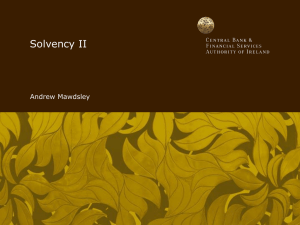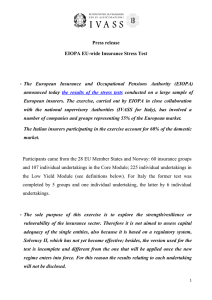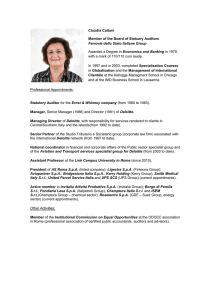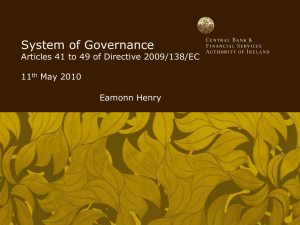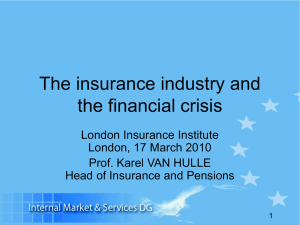Solvency II
advertisement
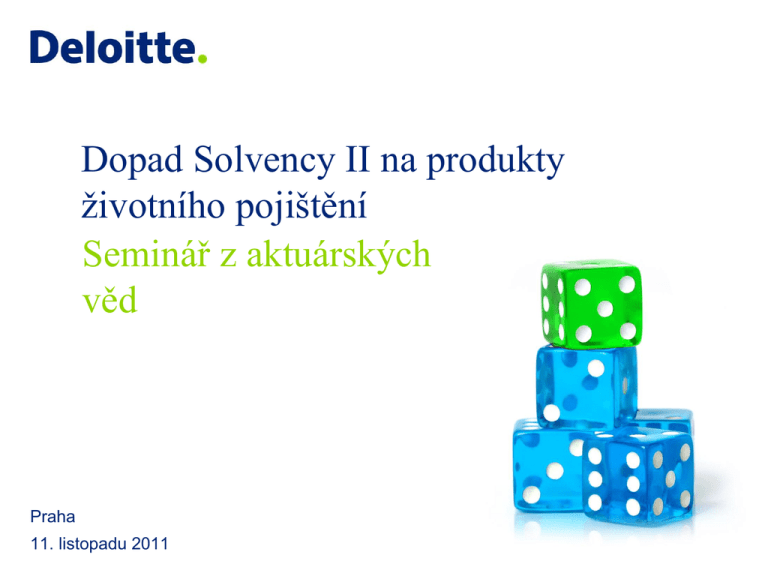
Dopad Solvency II na produkty
životního pojištění
Seminář z aktuárských
věd
Praha
11. listopadu 2011
Agenda
1
Introduction
Economic Balance Sheet Approach & QIS5 results
Solvency Capital Requirement & QIS5 results
2
Impact of SII on Life Insurance Products
Traditional Participating Life Insurance Products
Unit-Linked Products
Risk Products
Annuities
Life Products Summary
2
3
Impact of SII on Asset Liability Management
4
Conclusions
Dopad Solvency II na pojistné produkty
© 2011 Deloitte Česká republika
Introduction
What is Solvency II?
• Solvency II is a new solvency regime for all EEA insurers and reinsurers
• It is based on three guiding principles (pillars) which cut across market,
credit, liquidity, operational and insurance risk
Pillar 1
Quantitative
Market Risk
Market Risk
Credit Risk
Credit Risk
Liquidity Risk
Liquidity Risk
Operational Risk
Operational Risk
Pillar 1
Quantitative
Requirements
Regulations on
minimum capital
Regulations
on
requirements
minimum capital
requirements
Requirement (SCR)
Solvency Capital
Requirement (SCR)
Technical provisions
Technical provisions
SOLVENCY
II
Pillar 2
SOLVENCY
II
Qualitative
Pillar 2
Requirements & Rules
onQualitative
Supervision
Requirements & Rules
on Supervision
Regulations
on financial
services supervision
Regulations on financial
services
supervision
Own
Risk and
Solvency
Pillar 3
Supervisory
Pillar 3
Reporting and Public
Supervisory
Disclosure
Reporting and Public
Disclosure
Transparency
Transparency
Assessment (ORSA)
Own Risk and Solvency
Assessment
(ORSA)
Capabilities
and
powers
Disclosure requirements
of regulators, areas of
Capabilities
and powers
activity
of regulators, areas of
activity
Competition related
elements
Competition related
elements
Disclosure requirements
Underwriting Risk
Investment Rules
Quantification
4
Dopad Solvency II na pojistné produkty
Governance
Disclosure
© 2011 Deloitte Česká republika
Solvency II timetable
2010
2009
QIS
L1
L2
Nov 08
QIS4 results
published
Apr /May 09
SII Directive
approved by
European
Parliament / by
Council
Mar 09, Jul 09, Nov 09
CEIOPS issued L2
consultation papers
Mar 11
QIS5
report
published
Dec 09
SII Directive
published
Jan 11
Omnibus II
Directive drafted
Nov 09, Jan 10,
Apr 10: CEIOPS
Final L2 advice
submitted to EC
EC proposals for L2
measures
Jan 12
Omnibus II
adoption
Commission Freeze
Level 2
Delegated
Acts
Endorsement
Apr-Dec 11: EIOPA
drafts binding technical
standards.
End Dec 11: Final
proposal for BTS to EC
BTS
Oct 10-Dec 11
EIOPA develops L3 guidelines
Pre-consultation on L3 guidelines with
selected stakeholders (not public)
L3
5
Jul 10
CEIOPS
published
QIS5 spec
2012
2011
Dopad Solvency II na pojistné produkty
Consultation
and
adoption
© 2011 Deloitte Česká republika
Economic Balance
Sheet Approach &
QIS5 results
Economic Balance Sheet Approach
• Capital requirement should be based on a total balance sheet approach based on
economic valuation of all assets and liabilities.
• An economic valuation of assets and liabilities implies that:
•
Assets should be valued at market value where this is both available and provides a
reliable and appropriate valuation or mark-to-model value where this is not the case
•
Liabilities should be value on a best-estimate basis (economic value of liabilities)
• Economic value of liabilities:
•
Expected present (based on risk free curves) value of future liability cash flows using
best estimate assumptions i.e. not including prudence
•
Value of embedded financial obligations, including options and guarantees
•
Risk Margin (RM) for non-hedgeable financial and non-financial risks
• Difference between economic value of assets and liabilities gives net asset value
(NAV), also called own funds or available capital
7
Dopad Solvency II na pojistné produkty
© 2011 Deloitte Česká republika
From Solvency I to Solvency II
Solvency I
Solvency II
Free Surplus
Free
Surplus
Solvency I Capital
Requirement
Book value
of Assets
Statutory
Technical
Provisions
Solvency II capital
requirement (SCR)
Revaluation
of technical
provisions
Minimum capital
requirement (MCR)
Market Value
of Assets
Assets
covering
technical
provisions,
the MCR and
the SCR
•
•
8
Risk margin
Best estimate
•
Solvency II
valuation
rules
Solvency II available
capital (own funds)
Technical provisions
Both assets and liabilities are to be fair-valued (market value of assets and
liabilities). Assets also contain the reinsurance recoverables (after
correction for default risk of the reinsurer).
An explicit risk margin (market value margin) is to be added to the fair value
of the liabilities (Best Estimate) to give the technical provisions.
This risk margin should be calculated using the Cost of Capital method.
© 2011 Deloitte Česká republika
Czech Republic (QIS5): Development of own funds
CZK bn.
100
90
80
EPIFP
70
60
50
40
30
20
10
0
Source: Deloitte – QIS5 Results Consolidation for Czech Insurance Association (ČAP)
Note: Data for all the insurance companies (life, non-life, composite) that submitted data to CAP (35 insurance companies, 23 participated
in QIS 5, 18 submitted to CAP)
9
Dopad Solvency II na pojistné produkty
© 2011 Deloitte Česká republika
Czech Republic (QIS5): Revaluation of technical
provisions
Source: Deloitte – QIS5 Results Consolidation for Czech Insurance Association (ČAP)
Note: Based on submissions to CAP
10
Dopad Solvency II na pojistné produkty
© 2011 Deloitte Česká republika
Revaluation of life technical provisions – comparison of
CZ and EEA
Source: Česká národní banka – Prezentace výsledků QIS5
11
Dopad Solvency II na pojistné produkty – dodatek
© 2011 Deloitte Česká republika
Solvency II and market consistent valuation
Comparison of Own Funds and Embedded Value
Adjusted Balance
sheet & Embedded
Value
Solvency II
Adjusted
Statutory Equity
(ANAV)
Own funds
CRNHR
Risk margin
Assets
Assets
Best estimate
Embedded Value
CE PVFP
FCRC
TVOG
SII Technical
provisions
Statutory technical
provisions
•
•
Solvency II own funds and Embedded Value (EV) are closely related concepts
The very same cash-flow projection can be used to calculate EV and SII technical provisions – projection of future profits (FP)
under EV includes changes in statutory TP and investment income on statutory TP, the present value (PV) of these two items is
equal to starting amount of statutory provisions if discounted by the consistent discount rate (RFR), thus:
𝑃𝑉 𝐹𝑃 = 𝑃𝑉 𝑝𝑟𝑒𝑚𝑖𝑢𝑚 − 𝑃𝑉 𝑜𝑢𝑡𝑔𝑜𝑒𝑠 𝐵𝐸 − 𝑃𝑉 𝑒𝑥𝑝𝑒𝑛𝑐𝑒𝑠 𝐵𝐸 − 𝑃𝑉 ∆𝑇𝑃 𝑠𝑡𝑎𝑡 + 𝑃𝑉 𝑖𝑛𝑣𝑒𝑠𝑡𝑚𝑒𝑛𝑡 𝑖𝑛𝑐𝑜𝑚𝑒
𝐶𝐸 𝑃𝑉𝐹𝑃 = −𝑇𝑃𝐵𝐸 + 𝑇𝑃 𝑠𝑡𝑎𝑡
12
Dopad Solvency II na pojistné produkty
© 2011 Deloitte Česká republika
Solvency Capital
Requirement & QIS5
results
Solvency Capital Requirements
Standard formula in QIS5
SCR
BSCR
Adj
SCROp
Correlation
SCRNonLife
SCRMarket
Correlation
Correlation
Premium
and reserve
Lapse
CAT
SCRDefault
Equity
Spread
Interest rate
Concentration
SCRHealth
SCRLife
Correlation
Correlation
Health SLT
Lapse
Mortality
Health NonSLT
Longevity
Life Cat
Health CAT
Disability
Morbidity
Revision
Life
Expense
Property
Currency
SCRIntang
= included in the adjustment for the
loss-absorbing capacity of technical
provisions under the modular approach
Illiquidity
14
Dopad Solvency II na pojistné produkty
© 2011 Deloitte Česká republika
SCR
A
d
j
Solvency Capital Requirement
SCRNonLife
Premiu
m and
reserve
Life Underwriting Risk
SCRMarket
Spread
Interest
rate
SCROp
SCRDefault
Equity
Lapse
CAT
BSCR
Con
centratio
n
SCRHealth
Mortality
Longevity
Disability
Lapse
SCRIntang
Health
SLT
Lapse
Mortalit
y
Health
NonSLT
Longevit
y
Life Cat
Health
CAT
Disabilit
y
Revisio
n
Life
Expens
e
Propert
y
SCRLife
SCR Life
FX
Expense
Revision
Cat
SCR for life underwriting risk
• The capital charge for each life underwriting risk is first calculated and then a correlation
matrix is used to determine the overall SCRlife
Mortality
Longevity
Disability
Lapse
Expense
Revision
Mortality
1
Longevity
-0.25
1
Disability
0.25
0
1
Lapse
0
0.25
0
1
Expense
0.25
0.25
0.5
0.5
1
Revision
0
0.25
0
0
0.5
1
Cat
0.25
0
0.25
0.25
0.25
0
15
Cat
1
© 2011 Deloitte Česká republika
SCR
A
d
j
SCR Life Underwriting Risk
Calibration
SCRNonLife
Premiu
m and
reserve
SCRMarket
Spread
Interest
rate
Propert
y
SCROp
SCRDefault
Equity
Lapse
CAT
BSCR
Con
centratio
n
SCRHealth
SCR Life
SCRIntang
Health
SLT
Lapse
Mortalit
y
Health
NonSLT
Longevit
y
Life Cat
Health
CAT
Disabilit
y
Revisio
n
Life
Expens
e
FX
Approach
• Aside from the lapse sub-module all capital requirements are determined by
a single direction shock on the net value of assets minus liabilities
• Example: Lifeexp = ΔNAV | expshock
Risk
QIS5 Draft TS
Mortality
Permanent increase mortality rates with 15% applicable to obligations contingent on mortality risk
i.e. where the amount currently payable on death exceeds the technical provisions. Where
(re)insurance obligations provide benefits both in case of death and survival and the death and
survival benefits are contingent on the life of the same insured person(s), these obligations
should not be unbundled (floor of 0 at contract level).
Longevity
Permanent decrease mortality rates with 20% applicable to obligations contingent on longevity
risk i.e. there is no death benefit or where the amount currently payable on death is less than the
technical provisions. Where (re)insurance obligations provide benefits both in case of death and
survival and the death and survival benefits are contingent on the life of the same insured
person(s), these obligations should not be unbundled (floor of zero at contract level).
Disability
A 35% increase in disability inception rates and a 25% increase for subsequent years.
Plus, where applicable, a permanent decrease of 20% in recovery rates (combined stress).
Applicable for obligations contingent on a definition of disability (compensation of losses or
medical expenses due to illness, accident or disability / where morbidity acts as an acceleration
of payments or obligations which fall due on death). Is likely to be applied only in cases where it
is not appropriate to unbundle contracts (otherwise in health module instead of life module).
16
© 2011 Deloitte Česká republika
SCR
A
d
j
SCR Life Underwriting Risk
Calibration
SCRNonLife
Premiu
m and
reserve
SCRMarket
Spread
Interest
rate
Propert
y
SCROp
SCRDefault
Equity
Lapse
CAT
BSCR
Con
centratio
n
SCRHealth
SCR Life
SCRIntang
Health
SLT
Lapse
Mortalit
y
Health
NonSLT
Longevit
y
Life Cat
Health
CAT
Disabilit
y
Revisio
n
Life
Expens
e
FX
Risk
QIS5 Draft TS
Lapse
Shock up and down of 50% of lapse rates (but limited to a maximum change). Lapse mass shock
of 30% of surrender strains for retail business and 70% for non-retail business.
Expense
Increase of 10% in future expenses compared to best estimate anticipations and increase by
1% per annum of the inflation rate compared to anticipations.
Revision
Increase of 3% in the annual amount payable for annuities exposed to revision risk. Only to be
applied on annuities (or benefits that can be approximated by annuity) arising from non-life
claims (excluding health SLT) where the amount of the annuity may be revised during the next
year.
Life Cat
Absolute increase in the rate of policyholders dying of 1.5 per mille over the following year.
Applicable to obligations which are contingent on mortality i.e. an increase in mortality increases
technical provisions.
17
© 2011 Deloitte Česká republika
Czech Republic (QIS5): Solvency ratio under SI and SII
Source: Deloitte – QIS5 Results Consolidation for Czech Insurance Association (ČAP)
18
Dopad Solvency II na pojistné produkty
© 2011 Deloitte Česká republika
Available and required capital
Upper chart:
•
Comparison of capital requirements under
Solvency I and Solvency II for Czech insurance
companies participating in QIS5 (left column)
•
Comparison of available capital under Solvency
I and Solvency II for Czech insurance
companies participating in QIS5 (right column)
Lower chart:
•
Solvency ratio under Solvency I (left column)
and Solvency II (right column)
•
According to CNB, the average solvency ratio
dropped from 376% (under SI) down to 222%
(under SII)
Source: Česká národní banka – Prezentace výsledků QIS5
19
Dopad Solvency II na pojistné produkty – dodatek
© 2011 Deloitte Česká republika
Solvency ratio – comparison under SI and SII
S2 solvency ratio
All insurers
7.5
The following charts points to issues with SI:
6.5
•
Low correlation between SI solvency ratio and SII solvency
ratio, somewhat higher if for L, NL and composite insurer
segments
•
Available capital: accounting basis (statutory accounting
versus fair value approach)
•
Required capital: ability to reflect risks the insurers are facing
(limited under SI)
5.5
4.5
3.5
2.5
1.5
0.5
0.5
1.5
2.5
3.5
4.5
S1 solvency ratio
5.5
6.5
Composite insurers
7.5
3.5
6.5
S2 solvency ratio
S2 solvency ratio
Life insurers
4.0
3.0
2.5
2.0
1.5
1.0
5.5
4.5
3.5
2.5
1.5
0.5
0.5
0.5
1.5
2.5
3.5
4.5
S1 solvency ratio
5.5
6.5
0.5
1.5
2.5
3.5
4.5
S1 solvency ratio
5.5
6.5
Source: Deloitte – QIS5 Results Consolidation for Czech Insurance Association (ČAP)
20
Dopad Solvency II na pojistné produkty – dodatek
© 2011 Deloitte Česká republika
Czech Republic (QIS5): BSCR and life underwriting risk
composition
BSCR composition (composite
companies)
Intangible
Health
asset risk
0.28%
underwriting
risk
1.21%
Counterpart
y default
risk
16.55%
Other risks
8.56%
Non-life
underwriting
risk
31.29%
Market risk
Life
25.25%
underwriting
risk
25.43%
Market risk
30.12%
Life underwriting risk (composite
Longevity
companies)
risk
2.56%
Revision risk
1.15%
CAT risk
5.13%
Mortality risk
6.23%
BSCR composition (life companies)
Life
underwriting
risk
61.32%
Life underwriting risk (life
companies) Longevity
risk
0.02%
Mortality risk
7.66%
Revision risk
0.00%
CAT risk
12.11%
Expense risk
16.89%
Lapse risk
50.35%
Expense
risk
18.82%
Disability risk
17.69%
Lapse risk
39.97%
Disability
risk
21.42%
Source: Deloitte – QIS5 Results Consolidation for Czech Insurance Association (ČAP)
21
Dopad Solvency II na pojistné produkty
© 2011 Deloitte Česká republika
BSCR risk composition – comparison of CZ and EEA
Source: Česká národní banka – Prezentace výsledků QIS5
22
Dopad Solvency II na pojistné produkty – dodatek
© 2011 Deloitte Česká republika
Life underwriting risk composition – comparison of CZ
and EEA
Source: Česká národní banka – Prezentace výsledků QIS5
23
Dopad Solvency II na pojistné produkty – dodatek
© 2011 Deloitte Česká republika
Impact of SII on Life
Insurance Products
Impact of SII on life products: Key considerations
Profit testing and cost of capital
Insurance companies use profit tests to
set premium and evaluate profitability
Cost of holding capital needs to be
considered
• Profit test: CF projection
• Difference between regulatory and risk
based capital
• premiums
• benefits (maturity, death, disability, surrender,
claims, profit-sharing)
• SI – does not reflect risks
• SII – does reflect risks
• expenses (acquisition, administration, claims,
investment)
• Introduces economic valuation and risk
based capital requirement
• taxes
• Higher capital required implies lower
return on capital, ceteris paribus
• cost of capital
• The change in SCR differs across
products => the relative profitability of
products will change
• Prices are likely to change to reflect the
real risk and cost to serve
• Change in calculation of available capital
– higher SCR mitigated by increase in
available capital (lower TP)
25
Dopad Solvency II na pojistné produkty
© 2011 Deloitte Česká republika
Impact of SII on life products: Further considerations
The impact of changes in capital required introduced by SII on prices and design of
insurance products will depend on a number of factors
Competitive environment in the
market (market structure - e.g.
monopoly, oligopoly)
Change in capital required
Prices and design
of insurance
products
Similarity between the current
regulatory regime and SII
Insurer operating models
(nature of ownership, product and
country diversification, customers,
products)
•
Deloitte UK conducted study for EC to assess the potential impact of SII L2 measures on products
•
Generalization of the analysis is difficult due to differences across countries and insurance companies
(existing regulation, tradition, product design, distribution channels, risk management, competition)
26
Dopad Solvency II na pojistné produkty
© 2011 Deloitte Česká republika
Traditional
Participating Life
Insurance Products
Traditional participating life insurance products
Product
Group
Country
Withprofits A
AT,DK, FI,
DE
Withprofits B
BE,CZ,
EE, HU,
IT, LT, LV,
NL, PL,
RO, SK,
SI
Withprofits C
Withprofits D
28
Profit Sharing based
on
total firm earnings on a
book value basis
the spread of booked
investment yields over the
guaranteed rate
CY, IE,
MT, GB
notional pool of
investments known as
“asset share”
FR, NO,
ES, SE
experience relative to the
assumptions in the
technical provision; 70-90%
of the margins achieved
over the assumptions in
the technical provisions are
paid as bonuses
Dopad Solvency II na pojistné produkty
Typical
Death
Benefits
Typical
Surrender
Benefits
based on
Options /
Guarantees
SI reserving
basis
Typical
Asset Mix
Includes accrued
maturity bonus
reservesincludes accrued
regular &
maturity bonus
May be some
GAOs /
guaranteed
interest rates
2.25-4%
Pricing basis (at
least at
inception)
Primarily
supported with
government and
investment
grade bonds
Uncommon
Between 90 –
110% of accrued
maturity benefit
reserves –
includes accrued
bonuses;
possible
surrender
charge
GAOs
uncommon/very
conservative
guaranteed
interest rate
(specified in
contracts)
Net premium
basis – very
conservative
with ass. usually
fixed at inception
Primarily
supported with
gov. bonds; little
or no equity
investment
Can be
significant
Typically equal
to the guarantee
and benefits +
applicable
terminal
bonuses
Close to 100%
of asset share;
could be < than
guaranteed
benefits
GAOs no longer
commonly
offered
Gross premium
basis – BE ass.
with a margin for
prudence set at
valuation date
Assets typically
invested in corp.
bonds and
equity; property
and gov. bonds
also present
May be based
on a guaranteed
sum assured
reserves – a
surrender
charge may be
applied
GAOs
uncommon/
guaranteed i.r.
typically equal to
invest. ass. in
reserving basis
Net premium
basis –
conservative
Primarily
supported with
fixed interest
investments
Maturity/
Terminal
Bonuses
Can be
significant
Uncommon
© 2011 Deloitte Česká republika
Traditional participating life insurance products
•
Technical
Provisions
•
•
SCR
•
•
•
•
Financial
impact of
SII
Risk
mitigation
29
Reduction due to move from a conservative to realistic basis (conservative
discounting rates, mortality basis and no allowance for future lapses)
Increase due to the impact of embedded options and guarantees (part of the
discretionary payments to policyholders included in technical provisions)
Significant increase in SCR due to market risk (≈ 50-70% of undiversified SCR)
and underwriting risk (the remaining part)
Market risk dominated by interest rate risk, UW risk by lapse and expense risk
Surrender values are related to SI reserves => mismatch between SII reserves
and surrender values and higher exposure to lapse risk
Higher unit expenses (compared to developed markets) result in relatively
higher SCR for expense risk
Risk absorbing effect of deferred taxes and management actions
•
•
Reduction in technical provisions offset by increase in SCR
QIS5 results for the Czech market indicate an increase in capital needs for
endowment products
•
Little reinsurance techniques currently in place and it is unlikely to change
dramatically (limited contribution of mortality risk to SCR)
Hedging exposure to interest rate risk not widely used but will become more
rewarding under SII
•
Dopad Solvency II na pojistné produkty
© 2011 Deloitte Česká republika
Traditional participating life insurance products
Product
prices
Prices likely to increase due to:
• Increase in SCR compared to SI required capital (=> higher cost of capital); and
• Increased variability of reserves due to embedded options and guarantees
•
Product
innovation
•
•
•
30
Consumer preferences unaffected by SII introduction (low attractiveness of
endowment products)
Costs and prices of endowment products likely to increase (also due to
embedded options and guarantees)
Under risk-based regime insurers have incentives either to increase prices for
endowments or limit the extent of embedded options and guarantees
Endowment products are likely to be even less attractive
Dopad Solvency II na pojistné produkty
© 2011 Deloitte Česká republika
Unit-Linked Products
Unit-linked products
Product
Group
Country
Premium
Loading
(Bid /
Offer
spread)
UnitLinked A
AT, DE
0-5%
UnitLinked B
BE, LU,
NL, PT
UnitLinked C
CY, FI, IE,
MT, GB
UnitLinked D
BG, CZ,
EE, HU,
LT, LV, PL,
RO, SK, SI
UnitLinked E
UnitLinked F
32
DE, FR
IT, ES, SE
Annual
Management
Charges
(p.a.)
Typical
Surrender
Penalty
Typical Death
Benefits
Typical
asset Mix
Maturity
Guarantee
Solvency I
reserves
Guaranteed
Annuity
Options
(GAOs)?
Approx.
0.5%
0%
Greater of {110% of
Fund Value; Fixed
Amount}
50% equity,
50% fixed
interest
No
MV of Units
On some
contracts
0.5-1.0%
0-5% in first year,
reducing over
early years of
contract
Greater of {Fund
Value; Fixed amount
or 100-130% of
premium}
40% equity;,
60% fixed
interest
No
MV of Units +
small death
benefits
reserve
No
1-5%
1-2%
Initially close to
100%;
decreasing to 0%
over the first few
years
Close to 100% of
Fund Value
60-80%
equity, 2040% fixed
interest
No
MV of Units +
Sterling
Reserves
No longer
commonly
offered, may
be sign. on
mature
portfolios
0%
1-2% +
additional
COI
100% in first
year, reducing to
0 over first 5
years of contract
One of {100-110% of
Fund Value; Greater
of Fund Value and
Fixed amount}
20-40%
equity, 6080% fixed
interest
No
MV of Units
No
0%
Greater of {Fund
Value;100% of
premiums or Fixed
amount}
40-60%
equity, 4060% fixed
interest
100-150% of
premiums at a
spec. date
MV of Units +
reserve for
maturity and
death
guarantees
No
0%
100-103% of Fund
Value
40-60%
equity, 4060% fixed
interest
No
MV of Units +
small death
benefits
reserve
No
3-5%
0-3%
2.5-3%
Dopad Solvency II na pojistné produkty
0.5-1.5% +
COI
1.5-2.5%
© 2011 Deloitte Česká republika
Unit-linked products
Technical
Provisions
Technical provisions are likely to be significantly reduced compared to SI:
• Release of capital since currently UL reserves have a floor equal to the unit fund
(and small reserve for death benefits)
• Under SII reserves lower than the unit fund if the PV of future charges is higher
than the PV of future expenses and costs (TP reduced by VIF)
SCR
SCR is likely to increase:
• Application of stress scenarios for calculating capital requirements to the VIF as
well as the value of the funds (flip side of allowing VIF to reduce TP)
• Lapse risk tends to be the largest single component of the SCR (loss of VIF and
surrender strain) accounting for approx. 80 – 85% of undiversified SCR
• Surrender values are related to unit fund => mismatch between SII reserves and
surrender values and higher exposure to lapse risk
• Market risk less significant (≈ 20% of SCR), driven to larger extent by equity risk
Financial
impact of
SII
Release of moderate amount of capital:
• Decrease in technical provisions
• Increase in SCR unlikely to outweigh reduction in TP, risks inherent in the return
and fund value are passed to PHs and only second round effects affect insurers
Risk
mitigation
33
•
Little reinsurance techniques currently in place and it is unlikely to change
dramatically (limited contribution of mortality risk to SCR)
Dopad Solvency II na pojistné produkty
© 2011 Deloitte Česká republika
Unit-linked products
Product
prices
Prices are unlikely to materially change:
• Moderate scope for price reduction as a result of capital release
• Insurers tempted to use release of capital to cross-subsidise other products
• Competitive pressures (not only among insurers but also from funds of collective
investments) may put downward pressure on prices
•
Product
innovation
•
•
34
Consumer preferences unaffected by SII introduction (UL products gradually
replace endowments)
Demand could be stimulated by price reductions if consumers found to be
sensitive to prices
Riders will be promoted (see the next section on risk products)
Dopad Solvency II na pojistné produkty
© 2011 Deloitte Česká republika
Risk Products
Risk products (e.g. term assurance)
SI reserving
method
Level of
Prudence in
Mortality Basis
Country
Product Type
Typical Contract
Duration
Term A
BG, PL, ES
Annually
renewable / Level
1-5 yrs
Net Premium
Large
Term B
CZ, FI, IT, RO, SK,
ES
Level
10-20 yrs
Net Premium
Large
Term C
CZ, ES
Decreasing
20-30 yrs
Net Premium
Large
Term D
CY, IE, NO, SE,
GB
Level
10-20 yrs
Gross Premium
Moderate
Term E
CY, IE, GB
Decreasing
20-30 yrs
Gross Premium
Moderate
Product Group
36
Dopad Solvency II na pojistné produkty
© 2011 Deloitte Česká republika
Risk products (e.g. term assurance)
Technical
Provisions
Technical provisions are likely to be significantly reduced compared to SI:
• Release of capital since these products are typically highly profitable (on a
realistic valuation basis)
• Under SII reserves can be even negative if the PV of future premium is higher
than the PV of future expenses and death benefits (as compared to SI net
premium reserves with a Zillmer adjustment)
SCR
SCR is likely to increase but the opposite impact is also possible (SI SaR effect):
• Underwriting risk is by far the most important risk (≈ 95% of undiversified SCR)
• Lapse risk (loss of VIF and surrender strain) tends to be the most important
driver of the SCR (estimated to represent 85 – 95% of undiversified UW risk)
• Mortality, catastrophe and expense risks considered less significant
• Market risk is immaterial (low reserves and return-insensitive benefits)
Financial
impact of
SII
Release of significant amount of capital:
• Decrease in technical provisions
• Revaluation of assets (difference between book and market values) not
expected to be significant
• Increase in SCR unlikely to outweigh reduction in TP
•
Risk
mitigation
37
•
Reinsurance techniques reduce the SCR, under SII full credit for reduction of
capital due to RI taken (unlike under SI, which imposes limit of 50% on RI)
Different types of RI arrangements in place (different premium rates and profit
sharing mechanisms)
Dopad Solvency II na pojistné produkty
© 2011 Deloitte Česká republika
Risk products (e.g. term assurance)
Product
prices
Prices are unlikely to materially change:
• Scope for price reduction as a result of capital release
• Price elasticity of demand is likely to be low, as well as competitive pressures
• Release of capital likely to be used to cross-subsidise other products/ maintain
profitability
•
Product
innovation
•
•
38
Consumer preferences unaffected by SII introduction (higher demand for life
protection products as consumers become more aware of risks)
Risk products likely to be supported and developed by insurers (extending the
scope of risks covered)
Demand could be stimulated by price reductions if consumers found to be
sensitive to prices
Dopad Solvency II na pojistné produkty
© 2011 Deloitte Česká republika
Annuities
Annuities
Product
Group
Annuity
A
Annuity
B
Annuity
C
Annuity
D
Annuity
E
Country
AT, DE
Product
Type
Immediate
Annuities
CY, IE,
GB
Immediate
Annuities
NL
Immediate
and Deferred
Annuities
NO, SE
ES
Immediate
Annuities
Immediate
Annuities
SI basis
Asset Mix Backing
Liabilities
Net Premium
Conservative mortality and
discount assumptions –
generally locked-in at issue
Primarily supported by gov.
and investment grade
corporate bonds
denominated in local
currency
Non-profit
Gross
Premium
BE assumptions for mortality
and discounting with a
margin for prudence set at
the valuation date
Primarily supported by gov.
and investment grade
corporate bonds
denominated in local
currency
Non-profit
Gross
Premium
Conservative assumptions
locked-in at issue
Primarily supported by gov.
bonds denominated in local
currency
Gross
Premium
BE mortality assumptions,
discount assumptions are
locked-in at issue
Primarily supported by
investment grade corporate
bonds. Between 80-90% of
assets are denominated in
local currency, the remainder
in EUR.
Net Premium
Conservative assumptions,
not locked-in at issue. When
A and L are matched, TP are
discounted using yields of
the backing assets.
Primarily supported by gov.
and investment grade
corporate bonds
denominated in local
currency
WP / NP
With-profits
With-profits
Non-profit
SI reserving
method
Note: As annuities are rare in the Czech Republic, the Czech Republic is not covered in the Study.
40
Dopad Solvency II na pojistné produkty
© 2011 Deloitte Česká republika
Immediate annuities
Technical
Provisions
Small reduction in technical provisions expected:
• Release of reserving margins (prudent discounting and mortality) due to move
to best estimate liabilities and inclusion of a liquidity premium
• Embedded options and guarantees unlikely to fully offset the release of margins
SCR
SCR is likely to be somewhat higher compared to SI:
• Market risk (≈ 75% of undiversified SCR) driven by interest rate risk and spread
risk
• Underwriting risk driven by longevity risk
Financial
impact
Total resource requirements under the QIS 5 remain more or less unchanged
•
Product
prices
41
•
Significant guarantees (in respect of longevity and interest rate) included. In the
past guarantees were priced implicitly only by including margins in pricing bases
combined with profit sharing
SII will show the level of risk capital required to support these guarantees, which
is likely to lead to a reduction of guarantees or increase in prices
Dopad Solvency II na pojistné produkty
© 2011 Deloitte Česká republika
Life Products
Summary
Life products summary
Traditional
participating
products
Unit-linked
products
Risk products
Annuities
Technical
provisions
Solvency capital
requirement
Financial impact
Increase
Uncertain
Decrease
•
Saving products (traditional with-profits products) and annuities – dominance of market risks
•
UL and risk products – underwriting risks more important (esp. lapse and expense)
•
Risk products also subject to mortality and disability/ morbidity risk, annuities to longevity risk
•
Products with fee-based income (UL and variable annuities) are generally less negatively affected than
products with spread-based income and shareholder profit participation (traditional with-profits products)
•
A balanced risk profile implies higher diversification benefits
43
Dopad Solvency II na pojistné produkty
© 2011 Deloitte Česká republika
Concluding remarks on life products
Other considerations
Product innovations – available
experience
• Immediate product innovations are
hardly to be expected – introduction of
risk-based regime in the UK (ICA –
individual capital assessment) did not
trigger product innovations
Internal models
• Firms using internal models will have
competitive advantage (capital
requirements lower by approx. 20%)
esp. due to:
• Correlations for market risk submodules and UW risk sub-modules
• Capital requirements at sub-module
level are comparable between internal
model and standard formulae
Harmonisation
• SII will harmonize asset/ liability
valuation approaches and capital
requirements throughout the EU
• However, differences in product design,
consumer preferences and level of
sophistication will remain
44
Dopad Solvency II na pojistné produkty
Product
prices &
innovations
Pricing considerations
• Pricing is likely to better reflect the
risks and the existence of embedded
options and guarantees
• There is a potential to allow for
diversification benefits in pricing – well
diversified firms could price more
competitively
• Change in the product mix (supply
driven) to the extent to which risks are
reflected in prices
© 2011 Deloitte Česká republika
Impact of SII on Asset
Liability Management
Closer ALM and changes in asset allocation
• Solvency II implies a step change in the way market risks are assessed
for solvency purposes
46
Solvency I
Solvency II
SCR based on fixed factors
=> the asset liability mismatch
and market risk taken not
reflected
SCR reflects both asset liability
duration mismatches and the
market risk of different
investment classes
Dopad Solvency II na pojistné produkty
© 2011 Deloitte Česká republika
Asset structure – comparison of CZ and EEA
Source: Česká národní banka – Prezentace výsledků QIS5
47
Dopad Solvency II na pojistné produkty – dodatek
© 2011 Deloitte Česká republika
Czech Republic (QIS5): Market risk composition
Illiquidity
premium risk
0.25%
Market risk (life companies)
Equity risk
14,43%
Property risk
0.10%
Currency risk
22,94%
Concentration
risk
19,29%
Spread risk
8,35%
Market risk (composite companies)
Illiquidity
premium risk
1.72%
Currency risk
6.01%
Property risk
6.66%
Concentration
risk
16.79%
Interest rate
risk
34,64%
Interest rate
risk
17.04%
Equity risk
32.86%
Spread risk
18.93%
Source: Deloitte – QIS5 Results Consolidation for Czech Insurance Association (ČAP)
48
Dopad Solvency II na pojistné produkty
© 2011 Deloitte Česká republika
Market risk composition – comparison of CZ and EEA
Source: Česká národní banka – Prezentace výsledků QIS5
49
Dopad Solvency II na pojistné produkty – dodatek
© 2011 Deloitte Česká republika
Closer ALM and changes in asset allocation
Possible responses of insurers to the change in the calculation of SCR
Closer asset-liability matching –
or at least a greater emphasis on
monitoring this
• Adjustment of interest rate position of
insurers
• Managing assets relative to the
Solvency II liability profile
• Adjustment of asset duration (by
adjusting the duration of bonds and by
entering fixed income derivatives
positions)
• Monitoring the asset liability mismatch
position much more actively
• Larger and more sophisticated ALM
functions in insurance companies
SII standard formulae seems to
create an “unlevel” playing field
in the risk-reward between
different asset classes
• Adjustment of the asset allocation to
reflect the new capital requirements
• Optimizing return on SII capital
• Differences in expected return on
the SCR between asset classes
• Expected return on SCR similar for
equity, other equity and property
• Significant differences for credit
investments of different durations
• Invest in EEA gov. bonds (zero SCR
for spread risk) to help manage
asset-liability duration risks
• Swaption programs to manage
interest rate risks: insurers choose
to hold assets too short in duration
50
Dopad Solvency II na pojistné produkty
© 2011 Deloitte Česká republika
Risk-reward between different risk asset classes
Example
Standalone standard capital requirements by risk
asset class
60.0%
49.0%
50.0%
39.0%
40.0%
30.0%
25.0%
20.0%
14.0%
10.0%
9.8%
7.0%
4.2%
0.0%
Equity Other Property Credit A- Credit A- Credit A- Credit A(listed in equity
rated
rated
rated
rated
EEA or
(10y)
(7y)
(5y)
(3y)
OECD)
•
Equity – equity shock (30%) plus symmetric adjustment (9%)
on the basis of QIS5 TS
•
Other equity – equity shock (40%) plus symmetric adjustment
(9%) on the basis of QIS5 TS
•
Property – property shock (25%) on the basis of QIS5 TS
•
Credit – corporate credit for A-rated debtor obtained on the
basis of spread risk factor Fup (1.4%) and by applying QIS5
formulae:
𝑢𝑝
Illustrative risk adjusted returns on capital
•
Obtained on the basis of standalone capital requirements (see
above) and illustrative expected excess return
•
The following illustrative expected excess return over risk free
rate were assumed:
•
•
•
•
•
•
•
51
Equity:
Other equity:
Property:
Credit 10y:
Credit 7y:
Credit 5y:
Credit 3y:
3.3%
4.3%
1.9%
1.3%
1.2%
1.1%
0.9%
Dopad Solvency II na pojistné produkty
𝑑𝑢𝑟𝑎𝑡𝑖𝑜𝑛𝑖 ∙ 𝐹
𝑟𝑎𝑡𝑖𝑛𝑔𝑖
20%
18%
16%
13%
12%
10%
8%
8%
9%
8%
8%
4%
0%
Equity Other Property Credit A- Credit A- Credit A- Credit A(listed in equity
rated
rated
rated
rated
EEA or
(10y)
(7y)
(5y)
(3y)
OECD)
© 2011 Deloitte Česká republika
What are the likely asset allocation trends?
Shift towards short-dated credit
investments and a ‘divorce’ of
the duration of the physical
investment portfolio and liability
duration
Expected
changes to
insurers’
asset
allocation
Maintaining low allocations to
equity and property
Greater use of derivatives for
risk management (esp.
swaptions to manage interest
rate and duration mismatch risk)
Taking tactical risks where risk
budgets allow (if high SII capital
buffers exist)
• Companies’ individual preferences for taking risk in their investment strategy vary with:
•
Their level of surplus capital under SII
•
The level of capital they wish to allocate towards market risk (“risk budget”)
• Given the high expected returns on SCR for short-dated credit investment, the optimal
portfolio for general account liabilities is dominated by short-dated credit investments
52
Dopad Solvency II na pojistné produkty
© 2011 Deloitte Česká republika
Conclusions
Conclusions
• Solvency II results in a significant change in capital requirements
• Solvency II will have an impact on insurance product costs, thus potentially on
their pricing
• Impact on life insurance products:
•
Traditional endowment products with guarantees are facing substantial increase in
capital requirements
•
Unit-linked products and risk products seem to be the relative winners
• The importance of ALM will increase reflecting the contribution of market risk to
the total SCR
54
Dopad Solvency II na pojistné produkty
© 2011 Deloitte Česká republika
Děkuji za pozornost!
Deloitte označuje jednu či více společností Deloitte Touche Tohmatsu Limited,
britské privátní společnosti s ručením omezeným zárukou, a jejích členských
firem. Každá z těchto firem představuje samostatný a nezávislý právní subjekt.
Podrobný popis právní struktury společnosti Deloitte Touche Tohmatsu Limited
a jejích členských firem je uveden na adrese www.deloitte.com/cz/onas.
© 2011 Deloitte Česká republika

